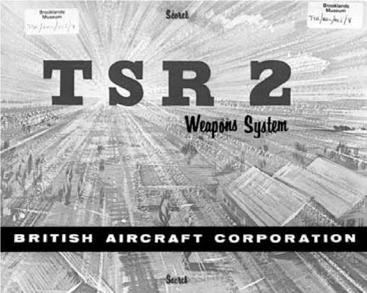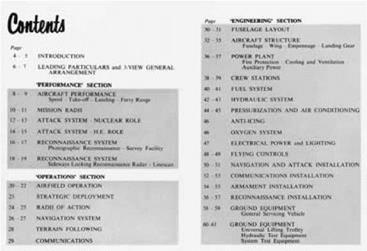In order to make sense of all this I now want to tell a rather formal story. I want to imagine that we are concerned with five discourses, five separate discursive forms, five distributions, five modes of interpellation. Putting it in this formal way means that the differences that I make are too discrete, too clear, too abrupt. In practice, matters would always be more subtle, less clear. But I do so in order to make a simplicity that will help in the process of exploring a logic of interference.
The discursive forms.
Let me call this first form history, plain history. It is a story, a form of storytelling, that starts at the beginning and moves to the end. A follows B follows C. It is a story that charts the inception, the conception, the development of a project, its growth, and its decline. Perhaps it charts its cancellation. At any rate, it is a story that tells of the trajectory of a technoscience project. This small example of the genre comes from a book by a well-known military aviation journalist and commentator, Derek Wood.
By mid 1957 the RAF had formulated its basic requirement under the title of General Operational Requirement No. 339 and it was passed to the Ministry of Supply for action. The Controller Aircraft, Sir Claude Pelly, sent out a letter to industry on GOR.339 on September 9th. (Wood 1975,153)
There is obviously no such thing as ‘‘plain history.’’ All history, ‘‘plain’’ or otherwise, is a narration and a performance. It makes, distributes, and links things together, bringing them into being and asserting their significance (or otherwise) by chaining them into possibly chronological sequences. I’ll talk more about the properties of such ‘‘arborescent’’ arrangements in chapter 8. For the moment just let me observe that it performs them too, constituting some kind of truth regime and, no doubt, effecting some consequences. This little excerpt is just that, an excerpt. It makes one or two links in a narrative that would be much longer if we were to spend more time on it. But
in the present context this does not matter, for my point is that in many stories of social science-including those that have to do with technology—there is this sense of something like a lowest common denominator: the making of a series of linked dates and events. This, then this, then this. The effect is the production of something, a set of specificities, specific object positions, which will often subsequently come to act as the ‘‘raw material’’ for other forms of storytelling, other discourses. And at the same time, a set of more or less centered subject positions or a reader/author is produced that makes, that appreciates, that is interpellated, by ‘‘the facts as they are’’—the facts, for instance, about a project, an aircraft project.25
I’ll call the second discursive mode policy narrative. This mode tells a story that has something to do with the first narrative, that of plain history, but in policy narrative the specificities are distributed into chains that are energized and achieve value by being given some kind of pragmatic policy relevance. That is, the specificities that might have been built in ‘‘plain history’’ are now awarded the potential for judgment or for contributing to a judgment. This, then, is a normative form of narrative, one that chains itself together by distributing praise, blame, and responsibility. It is energized with polarities, with pluses and minuses. And it creates a series of engaged, normative, and more or less centered subject positions. Here is a small example of the genre.
Sixth, and probably the greatest single cause of increased costs, was the repeated delay in getting official decisions, and the permanent uncertainty which so grievously effected the rhythm of production and from time to time the morale of design and production teams. (Hastings 1966, 60)
So this is an instance of policy narrative, a story about TSR2, written by a historically minded policy practitioner, Conservative Member of Parliament (MP) Stephen Hastings. And the subject made in this form of writing is that of the judge, a location or a role in which the pros and cons, the lessons, may be weighed up.
Narrative style number three is somewhat like number two. It is about judgment, right and wrong. In particular, it is a way of talking and living that is ethical in character. Perhaps, then, the distinc – 56 Subjects tion is like that made by Max Weber between instrumental and value –
rational action. (See Weber 1978, 24.) Here, at any rate, is Labour MP Tam Dalyell in a parliamentary debate that took place immediately after the cancellation of the TSR2, a censure debate:
It is a sombre fact that as the twentieth century rolls on more and more science-based developments have evolved from armaments. The right hon. Gentleman is, tragically, historically accurate when he says that armaments have been the life-blood of industry, but the fact that he is historically right casts a pretty damning reflection on contemporary capitalism. . . . One of the reasons why I became a Socialist was my belief that in a Socialist set-up at least one had a chance of creating conditions in which technical progress could be freed from the armaments race. (Hansard 1964-65)
Wertrationalitat rather than Zweckrationalitat. Here the links that provide for the performance of the narrative are normative—but also ethical. The subject positions are interpellated and linked together by means of a particular sense of right and wrong. Interpellation—and relative subject coherence—are achieved by moral means.
Narrative number four is different again. This I will call esoteric narrative (though perhaps all narrative styles are more or less eso – teric—or at least more or less specific). This is because I want to find a way of talking about forms of storytelling that are both local and selfprofessedly analytical—as, for instance, is the case for most versions of academic storytelling. There are, to be sure, innumerable variants here, just as there are innumerable variants of policy storytelling and, for that matter, of historiography, plain history But sometimes, perhaps often, academia is a place that makes stories, but stories where the links, and so the reader positions, are indeed esoteric in quality: interpellative for a specialist reader, and drawing on but not very directly feeding back into other forms of narration. And it is this sense of removal, of strictly local relevance, that I want to catch by talking in this way So the story I am telling right now (though it performs arrangements that will in some measure interfere with other genres) is no doubt a version of esoteric narrative. But so too is this:
At this point, then, the project came properly into being. The
managers had been granted an area of relative autonomy by ac – Subjects 57
tors in the global network; they had been granted what we will call a negotiation space in order to build a local network. (Law and Callon 1988, 289)
This is Michel Callon and John Law working with actor-network theory, making arguments that operate in a more or less local space. And again, as is obvious, there is a relationship between this narrative and that of plain history. The one is, in some sense, parasitic on the other.26
And number five? This is rather different: let’s call it aesthetic. It is a form of narrative that has to do with distributing and performing pleasure, with what is beautiful. It makes, in short, a particular form of (no doubt gendered) aesthetic subject.27 This is an issue that I will look at more closely in chapter 6. For now, however, consider the following:
The cockpit felt almost detached from reality. There was no vibration; the only noise a subdued hum from the big turbo jets, the seat comfort as luxurious as an airliner’s and the air conditioning warm, fresh and comfortable. The instrument panels showed steady readings of flight conditions, engine and systems performance with no malfunctions; the radio for once silent.
Outside an unbroken cloud sheet stretching below to the pale northern horizon, varied in colour only here and there by long streaks of shadow laid by the low winter sun from behind strato cumulus domes.28
The excerpt is from a book by the test pilot Roland Beamont, and much could be said of it. For instance, like David Bailly’s vanitas it artfully bridges the distinction between public and private, but at the same time it also performs it. The pilot, or so we learn, is a cool technician (‘‘the instrumental panels showed steady readings,’’ and he recognizes ‘‘strato cumulus domes’’). But there is also poetry here, poetry, pleasure, and no doubt sadness too, the sadness of a loss that will come, as the TSR2 is grounded and destroyed. This, then, is a performance of a particular form of aesthetic narrative — another in- terpellative logic, the production of another subject position.














